Nelson Evans (1889-1922), who signed as "Evans, L.A.", was a photographer during the days of early Hollywood. Evans was known for his portraits of film actors such as Mary Pickford, Marie Prevost, Jackie Coogan, and many others during the silent film era including director Philip Rosen. He is also considered one of the creators of pin-up photography.
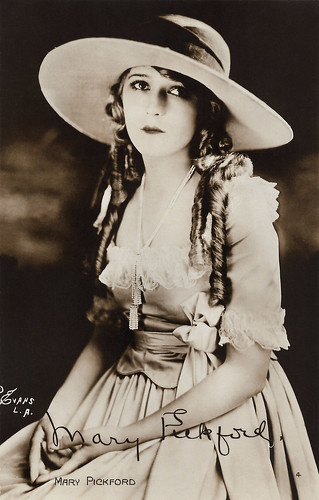
French postcard by Cinemagazine-Edition, no. 4. Photo: Evans, L.A.
Mary Pickford (1892-1972) was a legendary silent film actress and was known as 'America’s sweetheart.' She was a founder of United Artists and helped establish the Academy.

French postcard by Cinémagazine-Edition, no. 29. Photo: Evans, L.A.
American actor John Leslie 'Jackie' Coogan (1914-1984) began as a child star in silent films. He was Charlie Chaplin's irascible sidekick in The Kid (Charles Chaplin, 1921) and played the title role in Oliver Twist (Frank Lloyd, 1922). Many years later, he became known as Uncle Fester in the TV series The Addams Family (1964-1966). In the interim, he sued his mother and stepfather over his squandered film earnings ($48 million to $65 million adjusted for 2012 dollars) and provoked California to enact the first known legal protection for the earnings of child performers, widely known as 'the Coogan Act'.
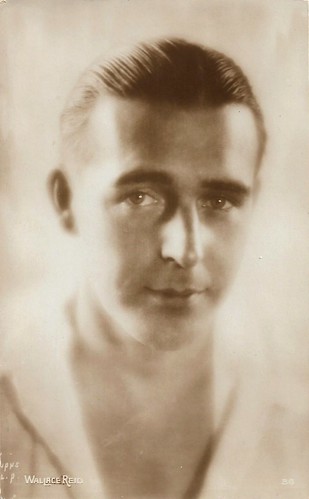
French postcard by Cinémagazine-Edition, no. 36. Photo: Evans.
Wallace Reid (1891-1923) was an American actor in the silent film referred to as "the screen's most perfect lover". A morphine addiction killed him, at the age of only 31.

French postcard by Cinémagazine-Edition / A.N., Paris, no. 296. Photo: Evans Studio, L.A.
Enid Bennett (1893-1969) was an Australian-born silent film actress, mostly active in the American cinema. She peaked in the late 1910s and early 1920s with films such as Robin Hood (1922), starring Douglas Fairbanks, and The Sea Hawk (1924). In the sound era, she played Jackie Coogan's mother in the Oscar-winning film Skippy (1931). She was the wife of director Fred Niblo and after his death of director Sidney Franklin.

French postcard by Cinémagazine-Edition, Paris, no. 358. Photo: Evans, L.A.
Clean-cut, sensitive Lloyd Hughes (1897-1958) was an American actor of both the silent and sound film eras. He appeared in such silent classics as Tess of the Storm Country (1921), The Sea Hawk (1924), and The Lost World (1925).
Nelson Frazier Evans was born in Columbus, Ohio in 1889. He was the son of a coal mine operator, who objected to Evans' choice to pursue a career in photography.
Initially working in the eastern United States, Evans moved to the west coast in the 1910s to pursue a career as a portrait photographer in Hollywood.
In 'Still: American Silent Motion Picture Photography', historian David Shields writes that Evans "had the most playful visual imagination of any of the early photographers of Hollywood". He took the first candid film star photos in an assignment for Photo-Play in late 1914.
In 1915, Evans established a studio at 6039 Hollywood Boulevard. At the time, Hollywood studio photographers focused mainly on shooting film stills of sets and scenes — actors and actresses were forced to find personal photographers to take portrait shots.
This market niche was filled by professional photographers like Evans. He also did more traditional still photography for a number of prominent film studios, including Paramount, Fox, Famous Players-Lasky, First National, and Metro Ince Studios.

Spanish postcard. Photo: Evans, Los Angeles.
Charles Ray (1891-1943) was an American actor, scriptwriter, and director of the silent screen, who knew a parabole from rags to riches and back again. He worked for Paramount, his own company, United Artists and MGM. In the late 1910s and early 1920s, he was a very popular actor and one of Hollywood's best-paid stars.
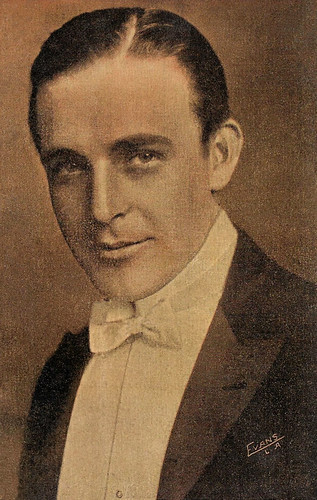
Spanish collectors card by Amatller Marca Luna, series 11, no. 20. Photo: Evans, L.A.
Wallace Reid (1891-1923) was an American actor in the silent film referred to as "the screen's most perfect lover". A morphine addiction killed him, at the age of only 31.

American postcard. Photo: Evans.
Bessie Barriscale (1884-1965) was an Edwardian-era stage actress, noted for her beautiful eyes. In films from 1913, the American actress became a major star with Thomas H. Ince and Kay-Bee until the early 1920s.
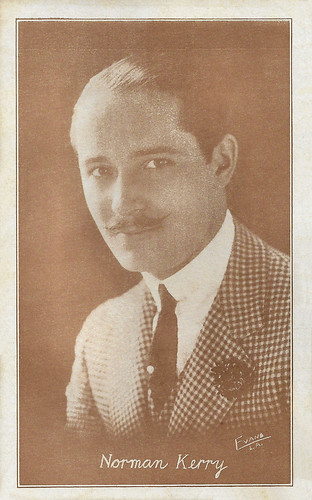
American postcard. Photo: Evans, L.A.
Norman Kerry (1894–1956) was an American actor of the silent era, who peaked in the Lon Chaney films The Hunchback of the Notre Dame (1923), The Phantom of the Opera (1925) and The Unknown (1927).
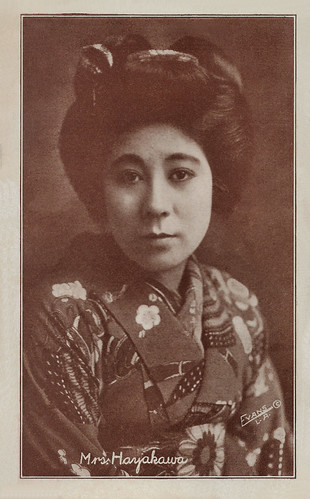
American postcard. Photo: Evans, L.A.
Screen and stage actress Tsuru Aoki (1892-1961) was the first female film star from Asia in the United States. Throughout the 1910s, Aoki would appear in approximately forty films, often in leading-lady roles. From 1914 on, she was married to Sessue Hayakawa and they co-starred in 20 films.
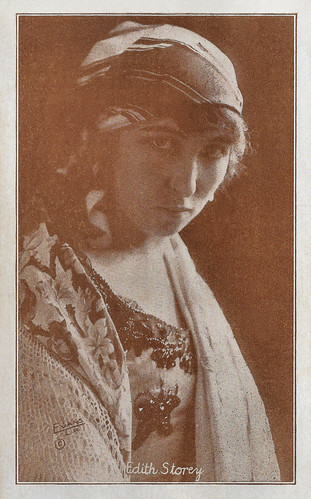
American postcard. Photo: Evans, L.A.
American actress Edith Storey (1892-1967) was a silent film star who was an unusual combination of an intelligent actress and an outdoor athlete. She often appeared in Westerns, period dramas and adventure films. For a long time, she worked for Vitagraph and in 1918, she became one of the stars of Metro.
Evans introduced several innovations to the photography scene of Old Hollywood. He avoided using the traditional fancy props like the ornate chair and the brocade drape. He painted effects or backgrounds directly on photo negatives.
Evans is also credited by David S. Shields with creating the genre of 'Cheesecake Photography', a forerunner to pin-up photography. He made seaside portraits of Mack Sennett's bathing beauties cavorting on the rocks and in the surf in swimwear. Some of these full-body swimsuit photos appeared in magazines and on cigarette packages.
During World War I, Evans was drafted into government service and stationed in New York City. He was commissioned as a first lieutenant and was involved with the growing field of aerial photography, for which he attempted to develop a new camera.
In the early 1920s, Evans rivaled Albert Witzel as Hollywood's favourite photographer. David S. Shields: "Evans borrowed liberally from a broader range of models than any of his competitors in Los Angeles. His focus could be sharp, like Mojonier, or as poetically soft as Sartov. He could shoot fanciful full-figure vignettes like James Abbe, or superbly lit and expressive close-ups like Melbourne Spurr."
In 1922, Nelson Evans died in Los Angeles at the age of 33. Following his death, Evans' studio was converted into an art gallery. In 1929, his studio was damaged by a fire possibly set as part of a wider vendetta against still photographers operating in Hollywood. Evans' early death resulted in him fading from memory more so than his contemporaries, such as Fred Hartsook and Witzel.

British postcard in the Cinema Chat series. Photo: Evans / Pathé.
Fannie Ward, a.k.a. Fanny Ward (1872–1952) was an American actress of stage and screen, known for The Cheat (1915), a sexually- and racially-charged silent film directed by Cecil B. DeMille. In the late 1910s, she did a series of films for Astra Films, released by Pathé Exchange.

British postcard. Photo: Evans / Fox. This card must be from around 1918-1920.
Albert Ray (1897–1944) was an American film director, actor, and screenwriter. He appeared in 22 films between 1915 and 1921 and he directed 85 films between 1920 and 1939.
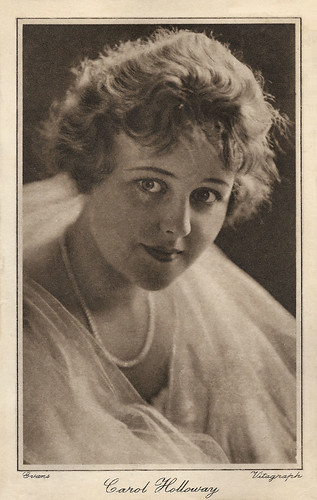
British postcard. Photo: Evans / Vitagraph.
Carol Holloway (1892–1979) was an American screen actress and writer. In the late 1910s, she was an important serial queen at Vitagraph.

British postcard. Photo: Evans / Vitagraph.
In the 1910s, Earle Williams (1880-1927) was the leading man of the American film company Vitagraph, often paired with Anita Stewart. He was subsequently successful at Paramount. Due to bronchial pneumonia, he already died when he was 47.
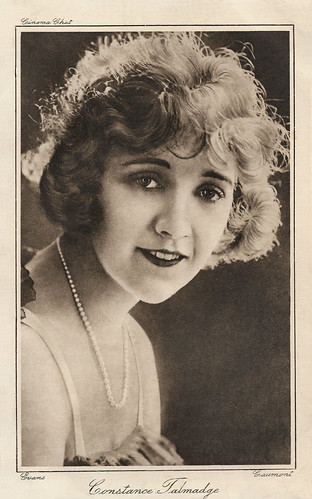
British postcard. Photo: Evans / Gaumont.
Constance Talmadge (1898-1973) was an actress of the American silent screen. Talmadge appeared in over 80 films, mostly comedies of manners. Together with her sister Norma, Constance Talmadge was billed as one of the biggest stars of the twenties.
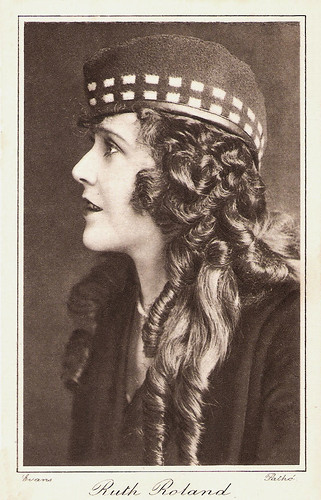
British postcard. Photo: Evans / Pathé.
Ruth Roland (1892–1937) was an American stage and film actress and film producer. Between 1911 and 1914 she was the leading actress of Kalem, from 1914 to 1917 she acted at Balboa Films, in popular serials such as The Red Circle, distributed by Pathé Exchange, and with Frank Mayo as her leading man. A clever businesswoman, she established her own production company, Ruth Roland Serials, and signed a distribution deal with Pathé to make seven new multi-episode serials that proved very successful, e.g. the crime serial The Adventures of Ruth (George Marshall, 1919) and the Western serial Ruth of the Rockies (George Marshall, 1920). In 1979 a concrete box with Roland's private nitrate film collection was found in her backyard and donated to the UCLA Film Archive, including the complete 12-part serial Who Pays? (1915) with Roland herself in the lead opposite Henry King (who co-directed as well).

British postcard. Photo: Evans / Vitagraph.
Edith Johnson (1894-1969) was an American actress of the silent era. She appeared in 66 films between 1913 and 1924, mostly serials, action films, and Westerns. She and husband William Duncan were "the king and queen of the serial".

British postcard by Beagles Postcards in the Famous Cinema Star Series, no. 247 T. Photo: Evans / Chaplin Film Co.

French postcard in the Les Vedettes du Cinéma series by Filma, no. 11. Photo: Evans, L.A. / Agence Générale Cinematographique.
Sources: David S. Shields (Still: American Silent Motion Picture Photography), and Wikipedia.
This was the last post in a series on photographers.

French postcard by Cinemagazine-Edition, no. 4. Photo: Evans, L.A.
Mary Pickford (1892-1972) was a legendary silent film actress and was known as 'America’s sweetheart.' She was a founder of United Artists and helped establish the Academy.

French postcard by Cinémagazine-Edition, no. 29. Photo: Evans, L.A.
American actor John Leslie 'Jackie' Coogan (1914-1984) began as a child star in silent films. He was Charlie Chaplin's irascible sidekick in The Kid (Charles Chaplin, 1921) and played the title role in Oliver Twist (Frank Lloyd, 1922). Many years later, he became known as Uncle Fester in the TV series The Addams Family (1964-1966). In the interim, he sued his mother and stepfather over his squandered film earnings ($48 million to $65 million adjusted for 2012 dollars) and provoked California to enact the first known legal protection for the earnings of child performers, widely known as 'the Coogan Act'.

French postcard by Cinémagazine-Edition, no. 36. Photo: Evans.
Wallace Reid (1891-1923) was an American actor in the silent film referred to as "the screen's most perfect lover". A morphine addiction killed him, at the age of only 31.

French postcard by Cinémagazine-Edition / A.N., Paris, no. 296. Photo: Evans Studio, L.A.
Enid Bennett (1893-1969) was an Australian-born silent film actress, mostly active in the American cinema. She peaked in the late 1910s and early 1920s with films such as Robin Hood (1922), starring Douglas Fairbanks, and The Sea Hawk (1924). In the sound era, she played Jackie Coogan's mother in the Oscar-winning film Skippy (1931). She was the wife of director Fred Niblo and after his death of director Sidney Franklin.

French postcard by Cinémagazine-Edition, Paris, no. 358. Photo: Evans, L.A.
Clean-cut, sensitive Lloyd Hughes (1897-1958) was an American actor of both the silent and sound film eras. He appeared in such silent classics as Tess of the Storm Country (1921), The Sea Hawk (1924), and The Lost World (1925).
A market niche
Nelson Frazier Evans was born in Columbus, Ohio in 1889. He was the son of a coal mine operator, who objected to Evans' choice to pursue a career in photography.
Initially working in the eastern United States, Evans moved to the west coast in the 1910s to pursue a career as a portrait photographer in Hollywood.
In 'Still: American Silent Motion Picture Photography', historian David Shields writes that Evans "had the most playful visual imagination of any of the early photographers of Hollywood". He took the first candid film star photos in an assignment for Photo-Play in late 1914.
In 1915, Evans established a studio at 6039 Hollywood Boulevard. At the time, Hollywood studio photographers focused mainly on shooting film stills of sets and scenes — actors and actresses were forced to find personal photographers to take portrait shots.
This market niche was filled by professional photographers like Evans. He also did more traditional still photography for a number of prominent film studios, including Paramount, Fox, Famous Players-Lasky, First National, and Metro Ince Studios.

Spanish postcard. Photo: Evans, Los Angeles.
Charles Ray (1891-1943) was an American actor, scriptwriter, and director of the silent screen, who knew a parabole from rags to riches and back again. He worked for Paramount, his own company, United Artists and MGM. In the late 1910s and early 1920s, he was a very popular actor and one of Hollywood's best-paid stars.

Spanish collectors card by Amatller Marca Luna, series 11, no. 20. Photo: Evans, L.A.
Wallace Reid (1891-1923) was an American actor in the silent film referred to as "the screen's most perfect lover". A morphine addiction killed him, at the age of only 31.

American postcard. Photo: Evans.
Bessie Barriscale (1884-1965) was an Edwardian-era stage actress, noted for her beautiful eyes. In films from 1913, the American actress became a major star with Thomas H. Ince and Kay-Bee until the early 1920s.

American postcard. Photo: Evans, L.A.
Norman Kerry (1894–1956) was an American actor of the silent era, who peaked in the Lon Chaney films The Hunchback of the Notre Dame (1923), The Phantom of the Opera (1925) and The Unknown (1927).

American postcard. Photo: Evans, L.A.
Screen and stage actress Tsuru Aoki (1892-1961) was the first female film star from Asia in the United States. Throughout the 1910s, Aoki would appear in approximately forty films, often in leading-lady roles. From 1914 on, she was married to Sessue Hayakawa and they co-starred in 20 films.

American postcard. Photo: Evans, L.A.
American actress Edith Storey (1892-1967) was a silent film star who was an unusual combination of an intelligent actress and an outdoor athlete. She often appeared in Westerns, period dramas and adventure films. For a long time, she worked for Vitagraph and in 1918, she became one of the stars of Metro.
Creating Cheesecake Photography
Evans introduced several innovations to the photography scene of Old Hollywood. He avoided using the traditional fancy props like the ornate chair and the brocade drape. He painted effects or backgrounds directly on photo negatives.
Evans is also credited by David S. Shields with creating the genre of 'Cheesecake Photography', a forerunner to pin-up photography. He made seaside portraits of Mack Sennett's bathing beauties cavorting on the rocks and in the surf in swimwear. Some of these full-body swimsuit photos appeared in magazines and on cigarette packages.
During World War I, Evans was drafted into government service and stationed in New York City. He was commissioned as a first lieutenant and was involved with the growing field of aerial photography, for which he attempted to develop a new camera.
In the early 1920s, Evans rivaled Albert Witzel as Hollywood's favourite photographer. David S. Shields: "Evans borrowed liberally from a broader range of models than any of his competitors in Los Angeles. His focus could be sharp, like Mojonier, or as poetically soft as Sartov. He could shoot fanciful full-figure vignettes like James Abbe, or superbly lit and expressive close-ups like Melbourne Spurr."
In 1922, Nelson Evans died in Los Angeles at the age of 33. Following his death, Evans' studio was converted into an art gallery. In 1929, his studio was damaged by a fire possibly set as part of a wider vendetta against still photographers operating in Hollywood. Evans' early death resulted in him fading from memory more so than his contemporaries, such as Fred Hartsook and Witzel.

British postcard in the Cinema Chat series. Photo: Evans / Pathé.
Fannie Ward, a.k.a. Fanny Ward (1872–1952) was an American actress of stage and screen, known for The Cheat (1915), a sexually- and racially-charged silent film directed by Cecil B. DeMille. In the late 1910s, she did a series of films for Astra Films, released by Pathé Exchange.

British postcard. Photo: Evans / Fox. This card must be from around 1918-1920.
Albert Ray (1897–1944) was an American film director, actor, and screenwriter. He appeared in 22 films between 1915 and 1921 and he directed 85 films between 1920 and 1939.

British postcard. Photo: Evans / Vitagraph.
Carol Holloway (1892–1979) was an American screen actress and writer. In the late 1910s, she was an important serial queen at Vitagraph.

British postcard. Photo: Evans / Vitagraph.
In the 1910s, Earle Williams (1880-1927) was the leading man of the American film company Vitagraph, often paired with Anita Stewart. He was subsequently successful at Paramount. Due to bronchial pneumonia, he already died when he was 47.

British postcard. Photo: Evans / Gaumont.
Constance Talmadge (1898-1973) was an actress of the American silent screen. Talmadge appeared in over 80 films, mostly comedies of manners. Together with her sister Norma, Constance Talmadge was billed as one of the biggest stars of the twenties.

British postcard. Photo: Evans / Pathé.
Ruth Roland (1892–1937) was an American stage and film actress and film producer. Between 1911 and 1914 she was the leading actress of Kalem, from 1914 to 1917 she acted at Balboa Films, in popular serials such as The Red Circle, distributed by Pathé Exchange, and with Frank Mayo as her leading man. A clever businesswoman, she established her own production company, Ruth Roland Serials, and signed a distribution deal with Pathé to make seven new multi-episode serials that proved very successful, e.g. the crime serial The Adventures of Ruth (George Marshall, 1919) and the Western serial Ruth of the Rockies (George Marshall, 1920). In 1979 a concrete box with Roland's private nitrate film collection was found in her backyard and donated to the UCLA Film Archive, including the complete 12-part serial Who Pays? (1915) with Roland herself in the lead opposite Henry King (who co-directed as well).

British postcard. Photo: Evans / Vitagraph.
Edith Johnson (1894-1969) was an American actress of the silent era. She appeared in 66 films between 1913 and 1924, mostly serials, action films, and Westerns. She and husband William Duncan were "the king and queen of the serial".

British postcard by Beagles Postcards in the Famous Cinema Star Series, no. 247 T. Photo: Evans / Chaplin Film Co.

French postcard in the Les Vedettes du Cinéma series by Filma, no. 11. Photo: Evans, L.A. / Agence Générale Cinematographique.
Sources: David S. Shields (Still: American Silent Motion Picture Photography), and Wikipedia.
This was the last post in a series on photographers.
No comments:
Post a Comment